In this review, we are going to show why we unexpectedly ended up really liking the HPE ProLiant ML110 Gen10 server. The HPE ProLiant ML110 is a pedestal server that is a little different than HPE servers of previous generations. It is a heavily cost-optimized tower server that is whisper quiet. If you are looking for the most powerful pedestal server on the market, the HPE ProLiant ML110 Gen10 is not your server. Instead, look at the ML350 Gen10. On the other hand, sometimes you simply need a well-built server for offices, retail locations, or even high-end home environments. For that, the ML110 Gen10 is simply excellent.
HPE ProLiant ML110 Gen10 Hardware Overview
From the front, the HPE ProLiant ML110 Gen10 may look small. Make no mistake, this is a full tower server at 17.32″ x 7.68″ x 18.92″. If you are looking for a tower/ pedestal server for a location without a rack, this larger form factor means one can fit a lot of functionality into the machine as we are about to see.

When you see the front panel of the HPE ProLiant ML110 Gen10 you immediately notice how porous it is. This bezel design keeps air flowing through the chassis. Of note, as a cost optimization, this bezel is included unlike in HPE’s higher-end servers. That is important because it is also extremely functional.

Behind that bezel, we have a quad LFF (3.5″) hard drive bay. You can see room above this hot swap bay for a second set of four drives. HPE also has SFF 2.5″ drive options and an optical drive option which our review unit was not equipped with.

We are going to take a second to highlight our least favorite part of the server, the front bezel latch. In order to release the front panel, you need to remove the side panel. You then have to push this lever up, and the front bezel moves away. If you are looking at the server from the exterior, this latch is not visible. That makes servicing unnecessarily complicated. We gave this feedback to the HPE team and they said they would look into it for future generations. It is a minor nit, but one that can be important if you need a non-technical resource to service a server in the field for emergency maintenance.

We are going to move to the rear of our system. Here you can see a fairly standard quad USB port, VGA port, configuration. There are three network ports, dual 1GbE ports for standard networking and a dedicated iLO 5 management port.

We are going to touch on the PCIe slots in a second, but we wanted to open the chassis up and point out a pattern you may be noticing: labeling. These tower servers are often located in small installations of one to a handful of servers in offices, retail outlets, or high-end SOHO settings. Servicing can happen through personnel other than trained IT staff. HPE does a great job labeling their systems so that someone in front of the machine attempting to complete a task has a basic map before they get started. Inside the ML110 Gen10 we see a map of the front, back, and internal motherboard of the server. This is something white box servers often overlook and it is a differentiator in this space.
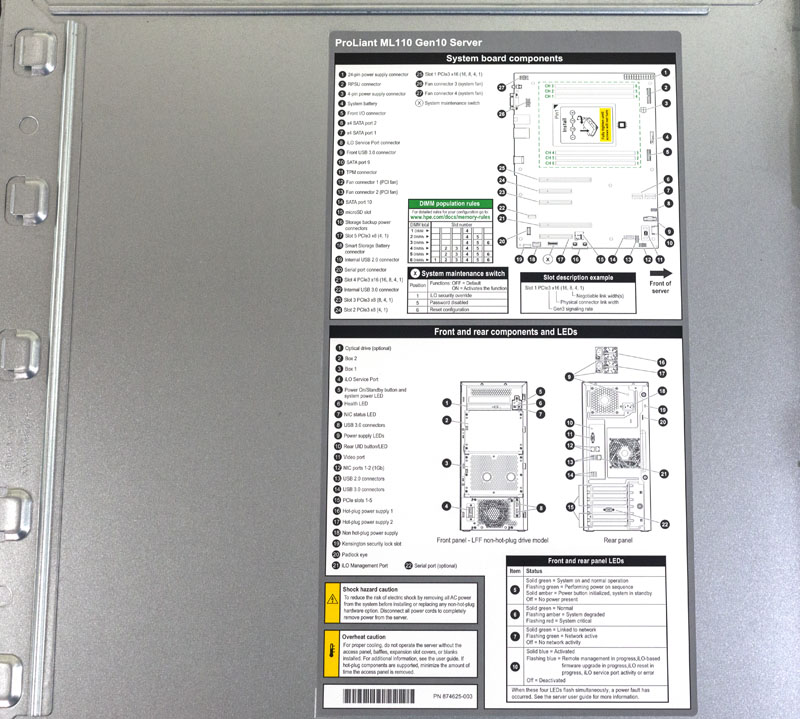
Documentation extends to online resources. Here is the internal map via the HPE Quick Specs documentation which gives a good overview of the server.

Taking a quick look inside, HPE uses a double air baffle system. That allows the server to stay cool even if the side panel is removed for front drive access. The baffles are solid units that are easy to service even without tools.
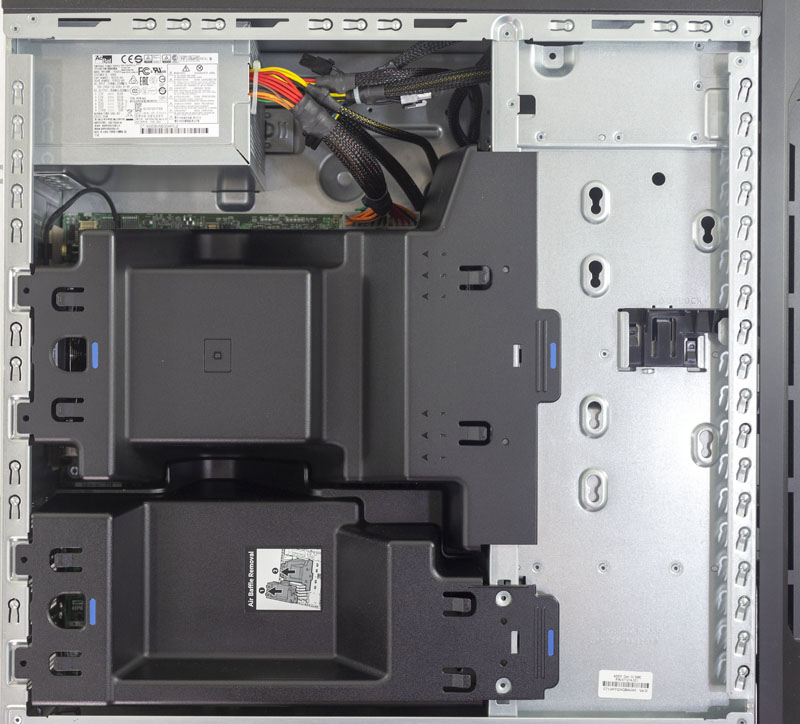
From a cooling perspective, the HPE ProLiant ML110 Gen10 is a single Intel Xeon Scalable CPU socket server with only six DDR4 DIMM slots. Intel Xeon Scalable can handle multiple processors and up to twelve DIMMs per CPU. This configuration allows the ML110 Gen10 to deliver maximum single socket CPU performance while still optimizing for low cost and power. The heatsink design is extremely interesting. You can see the labeling on the heatsink, but the shape is asymmetrical. Perhaps this helps airflow or saves a bit of cost, but it is a different design to what we see in many servers.
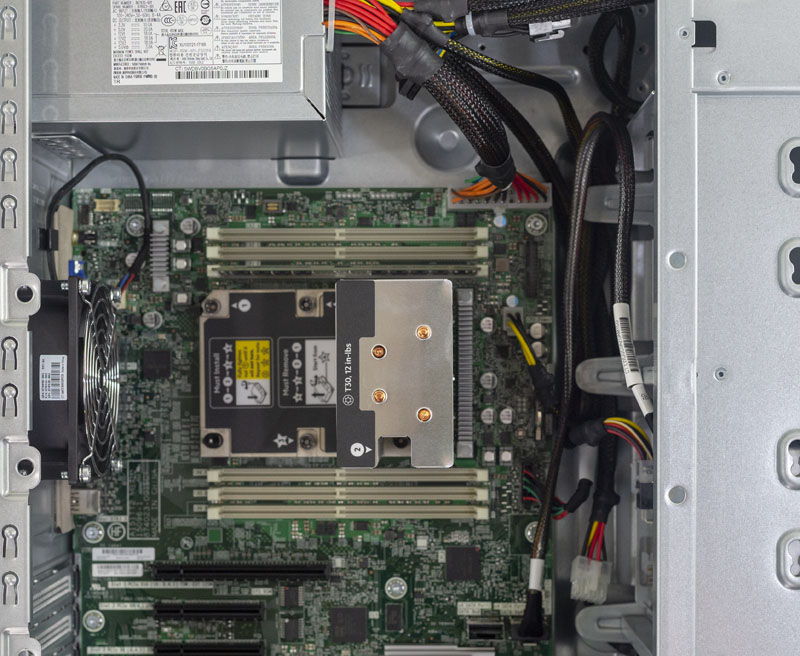
One of the standout features of the HPE ProLiant ML110 Gen10 is the PCIe configuration. There are five PCIe slots. There are a total of 44 of the platform’s maximum 48 PCIe slots exposed in this configuration along with an additional four lanes from the PCH (via an x8 physical slot.) That means that a user has five slots and up to 48 PCIe 3.0 lanes available for expansion. HPE’s product team did a great job of ensuring that the PCIe x16 slots had room for double-width cards such as GPUs, albeit one would likely want a bigger power supply with two GPUs.
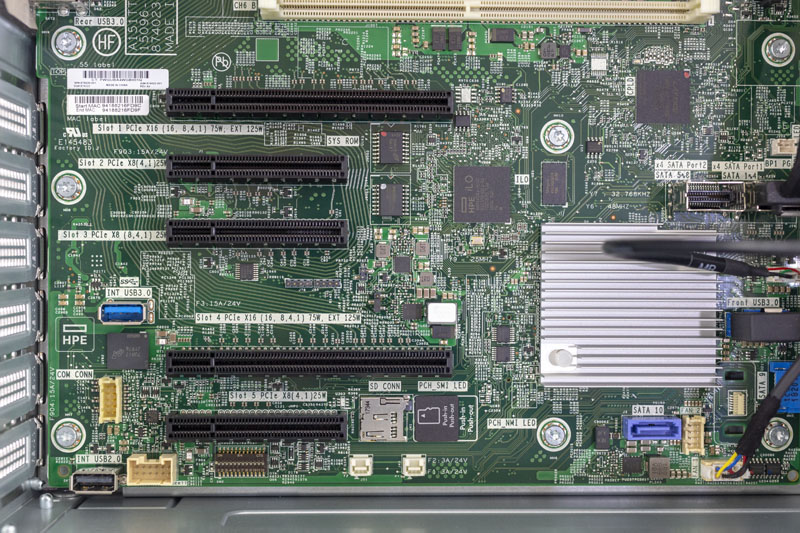
One can also see two internal USB Type-A headers along with a MicroSD card slot for embedded boot options or license key media.
These slots are all full height units. HPE shows off some excellent mechanical design here with its PCIe card locking mechanism. You will likely need a screwdriver, but everything is well-labeled and easy to service.

Primary storage for our unit was provided by a pair of SFF_8087 ports, each handling quad SATA lanes from the Intel Lewisburg PCH. Some vendors use a large array of 7-pin SATA cables which becomes more difficult to manage once four or eight cables are installed. Another benefit to the SFF-8087 connector is that there are SAS cards available that can utilize the same cables.

Onboard there are actually two 7-pin SATA III connectors, one is parallel to the motherboard while the other is perpendicular. All told, there are a total of ten SATA ports in the platform.
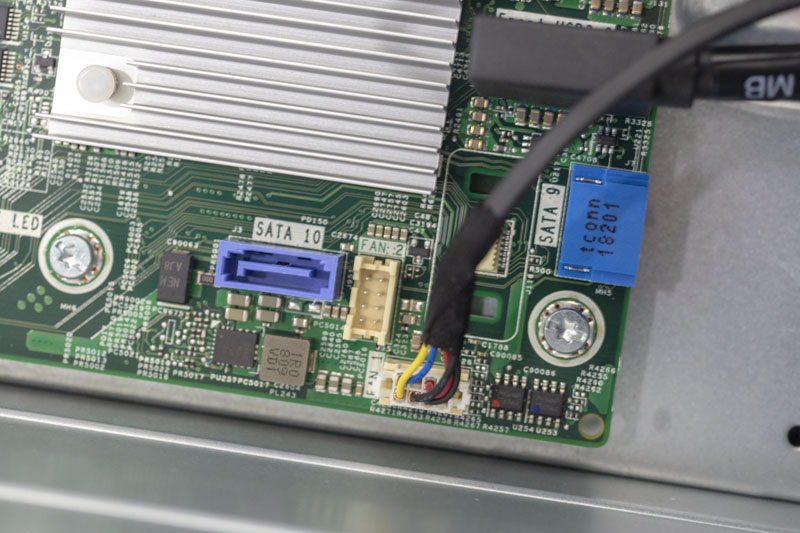
As you can see, our test unit did not have the maximum number of options available. At the same time, there were a few extra bits where HPE gave us something extra. One good example of this is the single 16GB DDR4 DIMM.
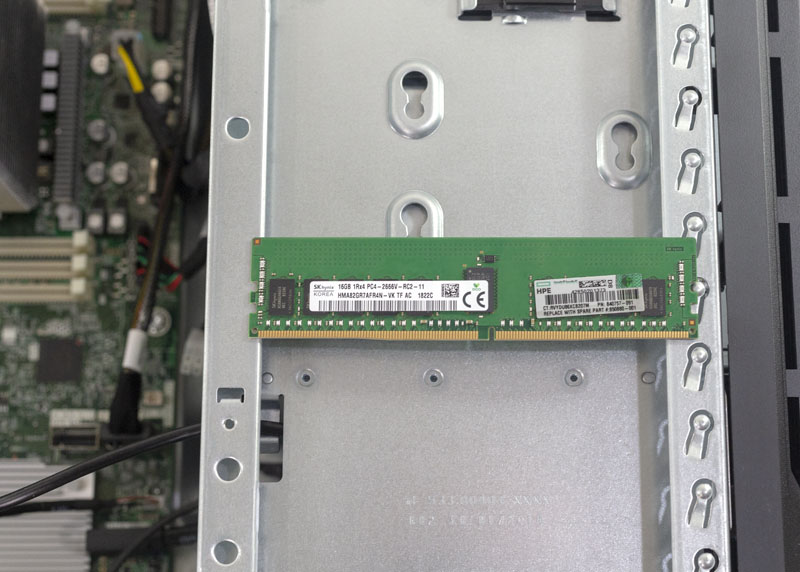
The 16GB DDR4 HPE Smart Memory DIMM is a SK.Hynix model. We were pleasantly surprised to see a DDR4-2666 unit installed. Current generation Intel Xeon Silver CPUs, like the Silver 4108 in our test system, are limited to DDR4-2400 speeds. HPE actually provided a slightly more premium part in our base configuration.
Next, we are going to look at our test system’s specs along with the iLO 5 management solution. We are going to follow that by looking at topology, performance, and power consumption before concluding with our final thoughts.





don’t want to jump too far ahead and spoil it – haven’t read this yet – but i wonder if it’ll be a 9.3, 9.4, 9.5 or *gasp* a 9.6?!?!?!?!
Honestly I do not understand whole this Bronze/Silver business. Single E-21xx can kill that price/performance/energy-consumption wise. So the only advantage of Bronze/Silver is RDIMM support and up to 768GB RAM. But with today’s prices who would buy this CPU with more than 64GB RAM and 64GB is still supported by E-21xx.
Really thorough review. Good job STH.
KarelG I looked at the specs it only supports 192GB according to HPE since there’s 6 DIMM slots.
Thank god you’re doing real reviews of servers. I hate the garbage pieces by itpro UK where they don’t even seem to review servers nor know why a server is like it is. Do more of these so I can write off itpro as vendor sponsored junk that it is.
I just sent this review to our procurement people for a pre BF buy. Timely.
Or you buy this and upgrade to a Xeon Gold for less than HPE charges… Smart Buy is the bomb tho. We use it all the time.
You didn’t mention this but HPE uses Torx screws everywhere. They suck and they’re difference sizes.
Well doe and thorough review
Thank you for the thorough review Patrick.
I had an unfortunate discovery on a Gen 9 ML350 with iLO4 and I am wondering if the same apparent weakness exists in the Gen 10/iLO5. The iLO on my server suffered a hardware failure. The BIOS then indicated it was preventing the OS from loading. In an attempt to work around it and get our server running, I tried to disable the iLO. Surely, my thinking went, since a BMC should just be for monitoring/management this should be possible, but nope, HPE made the iLO part of the BIOS dependency chain (this was an “upgrade”, in effect as of a certain firmware version, so apparently it’s not how the server was shipped).
Here’s the the note about inability to disable iLO in Gen9: https://support.hpe.com/hpsc/doc/public/display?docId=emr_na-a00018423en_us
Note that HPE support did promptly replace the motherboard in our server to address the issue, so the overall warranty/support experience was positive.
This exposed what seems a very poor design choice to me – essentially turning a positive feature/reliability improvement (BMC) into a potential liability. So I am curious if the Gen 10/iLO5 has the same design.
Also worth noting/remembering that HPE keeps BIOS updates behind a paywall (you have to have an active warranty/support contract). To me this limits resale value/ability to use these in a non-critical workloads (areas where it may otherwise be fine to not have a warranty but where you still want BIOS updates for security, reliability or other reasons). Dell and Supermicro do not do this (in my limited experience). So, depending on your use case, this may effectively reduce the value of any HPE server.
Ya’ll do awesome reviews. We’re fixin to get a few of these.
@Ryan, that does seem like an odd choice since OOB management can be an attack surface that some organizations choose to do without altogether. I know one could just leave the NIC unattached, but some vendors allow the option to expose OOB via the normal ethernet interfaces, so someone with root access could still hijack it…
There is a lot of talk about the iLO Advanced license, but no price is mentioned, or did I miss it?
WRONG for a small business! You can not buy the caddies for drives…you can only buy super expensive drives from HPE!!!!!
Patrick in your review of the MSG10+ you tested compatibility with various server OS including Proxmox. Can you speak to the compatibility of running Proxmox on the ML110 G10? I’ve seen some posts talking about issues installing Proxmox on prior versions of the ML110. Thanks.
Does this power measurements were made with all 8 HDDs installed in server? Because those are taking most of the power.
@Arvis – You can but drive caddies from third party manufactures on ebay – this is where I purchased mine.